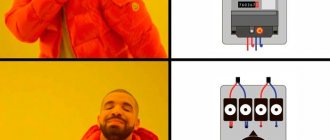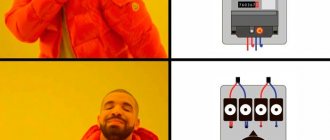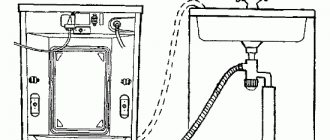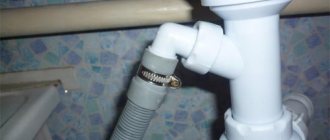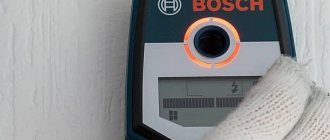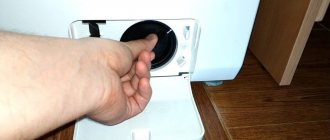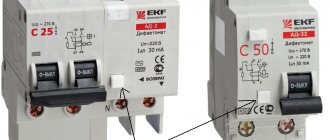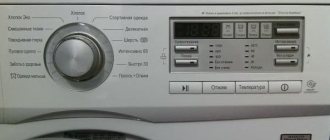What should you do if, after a certain period of proper operation, your machine or RCD in the electrical panel starts to trip when you turn on the washing machine?
Not everyone wants to immediately run to a service center, especially when the warranty has already expired. And transporting such large equipment is not an ordinary task.
In most cases, you can identify the breakdown and eliminate the cause yourself. The main thing is to know what to check and how.
Moreover, with a competent approach, it is possible to identify the cause of the shutdown even without special measuring instruments. There are several common symptoms and cases, let's look at them in order.
Problems with the electrical network or washing machine?
In order to prevent network overloads or a malfunction in the machine from completely destroying the equipment, it is necessary to establish why the meter is knocked out and eliminate the cause of the malfunction.
When the washing machine is under warranty or a complex electrical unit needs to be replaced, diagnostics and repair work must be carried out by specialists.
But perhaps the problem is in the power supply or in the contacts? Before you call a technician to your home, you need to find out why the meter goes off when you turn on the washing machine.
First you need to disconnect the device itself and household electrical appliances from the network and inspect the power circuits outside the washing machine.
See also -
Why does the washing machine jump or vibrate when spinning?
Why does the automatic machine work?
There are many reasons for knocking out an automatic rifle. Conventionally, they are divided into three groups. The first is a malfunction in the device itself, the second is difficulties with the load, the last reason is hidden in the line. Troubleshooting involves checking individual wiring lines one by one. article ⇒ Short circuit protection.
Reasons for triggering
Without load
In old houses in which worn-out and obsolete wiring has not been replaced, sudden current leaks may occur. Such unpleasant moments are associated with high air humidity, the presence of foreign objects or rodents and small animals.
The indicator shows the possible reason for the operation of the automatic device and its subsequent shutdown
In houses where the wiring has been replaced by the residents themselves, due to careless or incorrect installation in the panel, the automatic circuit breaker can often trip. Also the reasons for the failure may be:
- deformation of the protective insulation of the cable during its installation;
- the presence of cables laid in the thickness of the walls as the length of the cable twists increases;
- errors in determining the location of distribution boxes and insulation;
- incorrect selection of electrical fittings.
To understand the reasons why the automatic circuit breaker operates without a load, you should perform a detailed check of all electrical wiring. In this case, you will first have to identify which of the wiring groups is causing problems: lighting or socket group, because they are separate lines.
For example, when a machine is knocked out after turning on the lights, we can conclude that the reason lies precisely in this line. And if the automatic switch breaks when you turn on any electrical appliance, you can safely say that the problem is in the outlet line (but before that, you need to make sure that the device itself is working properly).
The differential automatic operates normally without the need to switch off
When shorting ground and zeros
The difavtomat is switched off if the device is installed incorrectly and the N and PE cables are connected in the socket or distribution box. Grounding and zero are combined on one PEN contact. If you consider the operation of the protection, you will notice that the outgoing current is divided into a pair of conductors, but only one of them goes through the differential transformer. This is why false alarms occur.
Often, inexperienced home electricians who do not have sufficient experience and do not fully understand the basics of the operation of the machine come across this question.
Under load
If the automatic circuit breaker operates periodically after connecting an electrical appliance, it can be assumed that there is an insulation fault in the electrical appliance. This suggests that using this electrical appliance is not entirely safe.
You should take all measures to identify the malfunction on your own or invite a technician to determine the cause and eliminate it.
Neglecting a malfunction can lead to serious consequences - electrical injuries to people in the house or a fire.
Tip No. 1: If the difatomat operates when connecting an electric drill, washing machine, vacuum cleaner or other equipment, you must immediately repair the device or take it to a repair shop.
When an automatic circuit breaker in an individual home trips on a functioning floor heating system, most likely the reason lies in the heating cable, which must be inspected, “ringed” and the fault repaired.
In case of voltage drop
The power supply to the circuit is turned off by the built-in diphatomat protection also when the voltage rises above the permissible value.
Not all device models can boast of having this function, but only those that have electronic control circuits installed.
The protection may also operate during switching on due to a short circuit inside the electrical appliance, since the automatic device can also turn off during a short circuit.
Also, the reason for the malfunction may be the unsatisfactory build quality of the difavtomat.
If the protection in the shield is knocked out after a certain time from being turned on, or only at a certain time of day, for example, at night, it is recommended to replace the device with a new one or an analogue from another manufacturer. But first you should make sure that such inclusions are not influenced by other factors described above.
Household reasons
As an example, consider the case of a washing machine.
First of all, it is necessary to exclude a fault from the load. To do this, connect any other household appliance - a refrigerator or an iron - to the same outlet instead of the machine. If there is no reaction from the machine, then the fault must be looked for in the washing machine itself.
When connecting a faulty washing machine to the socket, the automatic washing machine may work
Tip #2: Make sure that the phase wire is not shorted to the housing. The motor shields are excessively worn, and current flows through the graphite dust to the device.
The insulation resistance of the motor windings should be checked. When it drops below the level of 7-10 kOhm, the leakage currents reach such values that they trigger the automation.
There is no need to carry out a deeper inspection of the washing machine; it is better to call a professional to your home.
The reason for the machine tripping may not be the load. After installing repaired equipment, the problem may return again.
The reason is that the machine is switched on to the generalized leakage current in the power line: in the wiring from the load to the protection device and the machine itself.
Therefore, the total leakage current from the washing machine and the control load reaches such values that in one case the automatic machine will not turn off, but in the second it will work. Therefore, the insulation resistance in the electrical wiring should be checked.
Other reasons
In fact, the reason for the machine’s operation may be:
- high humidity penetrating the twisted wires of sockets and distribution boxes;
- unintentional deformation of electrical wiring insulation during installation with nails or screws;
- various manufacturing defects seen over time.
Finding and subsequently eliminating such faults is quite a long process and not easy even when examining open-type wiring. A break in the line and elimination of the defect is most easily accomplished by replacing the wire or installing a waterproof version instead of a regular socket.
Often you come across wires that are not of the best quality, insulated with materials that do not correspond to the class. This moment can also not be immediately determined, but subsequently all the wiring will have to be changed.
Troubleshooting
Knocking out when switching on new electrical wiring
When wiring is connected for the first time, troubleshooting should be done by checking the correct installation.
The automatic machine is first turned on in testing mode. If it works, then everything is fine with the device itself. Further actions are performed in the following sequence:
- it is necessary to make sure that there is no load;
- the machine turns on and when it is knocked out, it is concluded that the conductors are connected incorrectly;
- the connection to the N terminals of the neutral wire is checked, to the L terminal - the phase wire;
- the lower contacts of the machine are checked for correct connection of cables from the line to be monitored;
- An attempt is made to activate the protective device.
It is necessary to check where the “zero” wire comes from. It is supplied to the upper terminal from the zero bus. The “zero” is connected to the bottom contact from the line; it comes from the box. If the device is knocked out again, the reason must be sought in the connections in the switchboard.
Checking the shield
Most often, errors made during installation can be found in the panel - “zeros” from different lines are mistakenly connected or the connection points are mixed up.
When a fault occurs in the switchboard of a difavtomat, the cause may be an incorrect connection of the wires
Such mistakes are usually made by specialists who are accustomed to working only with automatic switches, for which it makes no difference which line the neutral cable is supplied from, since the devices themselves control the current on the phase cable. For an RCD or a differential circuit breaker, on the contrary, this is very important, since they react to the difference in the magnitude of currents in the phase and neutral wires.
After checking the correct connection in the distribution panel, you can turn on the machine. If it turns off again, you should make sure that the wires extending from the box to the outlet are connected correctly - the ground wire and the “zero” wire are no less often confused. If everything is correct, the machine should turn on and begin monitoring.
If you have doubts about the performance of the difavtomat itself, you can check it as follows. Using an indicator screwdriver, there is a “zero” in the socket, which is connected to ground.
Since no current flows through the phase and neutral wires without a load, the machine will not work. When you connect a load, even from a light bulb, the device will turn off. In the zero wire the current value will be 2 times less than in the phase wire.
This will trigger the electromagnetic release.
Checking the circuit
When a circuit breaker trips due to a short circuit, the cause is easiest to find. A device operating from a controlled line, as a rule, does not work. It is also equipped with fuses that blow, the body may be slightly blackened, and the wires may be slightly melted.
When connecting several devices to the line at once, the faulty device should be disconnected, and then the machine should be turned on again, which should immediately begin monitoring.
In case of a secondary shutdown, you should pay attention to the period during which this happened. If the device turns off immediately, it means it is shorting somewhere else.
Finding out the reason for the operation of the machine during a short circuit in the controlled network
Then the load should be turned off gradually - remove one consumer, turn on the machine and wait for its reaction. If the device is put under control, there is a malfunction in the disconnected device. If there is no control, we disconnect the next consumer.
Overload
If the machine does not turn off instantly when the load is connected, but some time later, we can conclude that there are overload currents, the magnitude of which is not enough for immediate operation.
Triggering of the automatic circuit breaker during overload can occur due to the connection of too powerful consumers
For this reason, the shutdown occurs due to the thermal release triggering when too many powerful appliances are connected.
If the cross-section of the electrical wiring allows, you can increase the number of sockets and install a device with a higher rated current instead of a difavtomat. article ⇒ How to avoid overloading an electrical circuit?
Plugs knock out when the washing machine is turned on: we are looking for the reason in the wiring
Due to the power supply system, the RCD circuit breaker trips in the following cases:
- When the RCD is of low quality, low capacity or incorrectly adjusted. This is the most common option and is possible when you turn on any function of the washing machine, even when draining the water. To forget about the problem, it is enough to adjust or replace the machine itself. (See also: How to choose an automatic circuit breaker (RCD) for a washing machine?)
- Increased load on the meter. When you turn on the machine, you must turn off other powerful electrical appliances, such as a microwave or electric stove.
- Damage to electrical wiring or socket. To check them, you need to connect an electrical appliance of the same power. When the RCD breaks out again, it means the reason is in the wiring.
The adjustment or replacement of the RCD must be carried out by specialists. Otherwise, unauthorized intervention in the machine, meter or traffic jams is fraught with overheating of the electrical network and ignition.
Serving fruit on the holiday table
The festive table is usually set not only for family members, but also for invited guests.
A festive feast will be considered a success if the table is beautifully and correctly set, and the guests at the table are comfortable and comfortable.
There are several rules for setting a festive table, following which any hostess will be able to show her ability to welcome guests at the highest level:
- The tablecloth for the festive table should be perfectly clean and ironed. It is advisable to spread a thick cloth on the table under the tablecloth, which will prevent the dishes from clanking if they accidentally fall, and will also protect the table surface from spilled liquids. However, it is permissible not to cover the table with expensive wood at all.
- Dishes and cutlery used for serving must be from the same set. It is unacceptable to serve the holiday table with dishes of different colors and sizes. The cleanliness and shine of dishes must be impeccable.
- Both plates and cutlery should be laid out only in the order in which the hostess plans to serve the dishes.
- There should be no unnecessary dishes and cutlery on the table. Items “just in case” are not needed, but will only spoil the appearance of the table.
- All alcoholic drinks are served in pre-opened bottles, but champagne is opened immediately before serving.
- One cloth and several paper napkins should be prepared for each guest.
- The hostess pours the first course into plates from the tureen for the guests. One of the guests or household members can help her serve filled plates. This must be done by approaching everyone present at the table from the right side.
- Guests put the second dish on their own plate from the common dish.
The presence of thematic decor in the center of the festive table will emphasize the efforts of the hostess and give the feast coziness and warmth.
Beautiful festive table setting
Before you start serving the table with fruit, you need to prepare small, sharp knives for slicing. It would be a good idea to stock up on tools that allow you to cut out shaped elements.
You can place fruit slices on a plate in different forms. The most commonly used silhouettes are the firebird, butterfly, and tower. The children's dish is laid out in the shape of some fairy-tale hero. For an anniversary, you can mark a significant date with fruits. Table setting at home, photos of which are presented below, will tell you options for decorating fruit slices.
Knocking out plugs: the cause of problems in the washing machine
So, the above options have been tested and not confirmed, therefore, the reason is in the device itself.
Before diagnostics or inspection, the device must be de-energized and make sure that there is no water left in the washer. Otherwise, there is a high probability of electrical and even mechanical injuries, since the washing machine contains rotating components and assemblies.
There are several reasons why traffic jams, an RCD or a meter knock out:
- due to damage to the plug or power cord;
- as a result of short circuit of the heating element;
- as a result of a malfunction of the network filter;
- due to a faulty engine;
- due to a faulty interference filter;
- as a result of a malfunction of the control button;
- due to damaged and frayed electrical wires.
Why does the RCD trip and what to do in this case?
You are here: It is very important to protect electrical wiring from current leakage, short circuits and overvoltage.
A residual current device will not only preserve the functionality of household appliances, but also protect you from electric shock.
If at some point you see that the RCD is tripping, do not panic, because that is exactly what it was installed for. Next, we will look at the main reasons for the device turning off, as well as what to do to troubleshoot the problem.
How does the device work?
So, first, let’s look at the operating principle of protective automation so that you understand why it triggers.
The internal mechanism has the following operating principle: a phase and neutral conductor are connected to the terminals, which are compared with each other in terms of current.
Ideally, there should be no difference between the current strength of the phase and the neutral working conductor. If there is a difference and it is higher than the setting, this is a signal that current leakage is occurring.
Based on the analysis, the unit is turned off, after which you immediately need to look for the reason why the RCD is triggered - to find a current leak.
We recommend watching videos that explain everything in detail:
Main reasons for shutdown
In fact, there are a lot of culprits for the operation and they can be of a very diverse nature, and, accordingly, the repair method. First, let's look at why the RCD is triggered, after which we will provide you with instructions for self-repairing faults.
Today, the following reasons are known why the product knocks out:
- There was indeed a current leak in the network. This may be due to the fact that the electrical wiring is old, because... In any case, the insulation has already dried out over time and in some areas the wire is exposed. If you have recently replaced the electrical wiring in your apartment, then the wires may have been connected poorly in certain places, or you may have accidentally pierced the insulation of the hidden wiring when driving a nail into the wall.
- The culprit may be electrical appliances that are protected by this device. Here, either the cord that connects to the network has failed, or the internal parts are “broken” (for example, the motor winding or the heating element of the water heater).
- Incorrect installation of protective automation, as a result of which the RCD does not work correctly and is triggered periodically. We have already provided instructions on how to properly connect an RCD with your own hands, so we recommend that you familiarize yourself with it.
- It is possible that when purchasing a protective automatic device you chose the wrong characteristics, and a false alarm occurs. We talked in detail about how to choose an RCD in the corresponding article.
- A residual current switch (DVT, as it is also called) can be knocked out due to a person touching a bare current-carrying conductor. Don't forget that this is its main purpose.
- A malfunction of the mechanism itself may be one of the reasons. For example, the “Test” button is stuck or the trigger mechanism is damaged, which will be triggered at the slightest vibration.
- Often a shutdown occurs due to improper placement of the DVT in the electrical wiring line. Look at one of the examples: a diagram for connecting an RCD in a single-phase network to find out where to install it.
- A short circuit between ground and zero during electrical installation work may result in a shutdown. Although the rules of the PUE are strictly prohibited from connecting the grounding to the neutral conductor, some electricians ignore the prohibitions and do everything their own way, citing the fact that this method will protect a person from electric shock (although in fact this only increases the danger).
- Weather conditions directly affect the performance of the device. For example, in wet weather, if the switchboard is installed outdoors, it may trigger due to dampness in the internal mechanism. In turn, the accumulation of moisture inside the product can cause a leakage current, as a result of which the mechanism will react. It should also be noted that in cold weather the RCD may sometimes not turn on in a dangerous situation. This is due to the fact that sub-zero temperatures negatively affect microcircuits, which cause them to fail. By the way, during a thunderstorm, there are cases when the protection is turned off, which is caused by the influence of lightning, which amplifies minor current leaks present in the house (or apartment)
- Well, the last nuance, which is closely related to the previous one, is increased humidity. If you installed hidden electrical wiring, then covered the route with putty and decided to immediately check the quality of the work done, a shutdown may occur. This is due to the fact that wet solution is a good conductor, which can cause leakage through the smallest cracks in the wiring. Wait until the solution has completely set, then check again whether the RCD is triggered or not, because Perhaps the lever no longer disengages.
Be sure to watch the video lesson, which clearly shows the erroneous connection:
Damage to the power cord or plug
Diagnostics always starts with the electrical wire and plug. During operation, the cord is subject to mechanical stress: it is pulled, overlapped, pinched. As a result of damage, the plug and electrical outlet do not make good contact.
Check the wire for damage with a multimeter. Replacing the power cord is as follows:
- it is necessary to turn off the power to the washing machine and close the inlet valve;
- use a hose to drain the water (turning the washing machine over is strictly prohibited);
- Unscrew the screws located around the perimeter and remove the panel;
- remove the surge protector from the housing by unscrewing the screw;
- press the latches, remove the plastic stopper by squeezing it out;
- move the electrical wire inward and to the side, thereby gaining access to the filter and disconnecting it;
- carefully pull out the power cord from the machine;
To install a new cord, you need to perform these steps in reverse order.
Professional assistance at the Tandem service center
If the washing machine is electrocuted, this is a serious reason to contact the service. Service is ready to help. Calling a technician and diagnostics are free services.
We employ certified craftsmen with specialized education. This ensures the quality and safety of the repair. We provide a 2-year warranty on all work. The cost of our work is lower than the market average, and additional discounts are provided to pensioners. The company's website runs promotions that help you save additional money.
Do not hesitate, contact specialists, safety in the house is the most important thing. The longer you wait to make repairs, the more complicated and expensive it becomes.
Short circuit of the heating element
Due to poor-quality water and chemicals, the heating element is “eaten up”, various impurities and scale accumulate. Heat transfer deteriorates, the heating element overheats and a short circuit occurs. As a result, the meter and traffic jams are knocked out.
To check the heater, disconnect the power cord and measure the resistance using a multimeter, setting the limit to ohm. Normally, the resistance should vary from 20 to 50 ohms.
Sometimes the heating element “shorts” to the body. To exclude this cause, the outputs and grounding bolts are measured for resistance one by one. Even a small reading on the multimeter indicates a short circuit, and this is the reason the RCD turns off.
To replace the heating element you need:
- Remove the back panel if the device is located at the rear. If the heating element is in front, first remove the control panel, then the front cover;
- Unscrew the nut of the grounding bolt approximately 6 turns, push the bolt inside;
- use a screwdriver to pry up the heating element and carefully remove it;
When replacing the heating element, do not tighten the nut tightly, since you can squeeze the heating element out of the tank.
Ways to solve the problem
Grounding the SMA
Modern washing machines are equipped with grounding. Connecting equipment other than the washing machine to the protective conductor creates a potential equalization system.
If this technical capability is not available in public utilities, then it is necessary to install a grounding loop yourself. Then you should run a protective three-core cable directly from the electrical panel to the outlet that is used for the machine.
Installation of protective shutdown
The problem can also be solved by installing a special disconnection device - an RCD - in the power supply circuit of the machine. The main parameter of this device is the cut-off current - the indicator at which the machine automatically turns off.
A 10 mA RCD will fit into a bathroom outlet
. The higher the risk level, the lower this indicator. For rooms with normal humidity, 30 mA is sufficient. Expert opinion
I work in the household appliance repair industry. Extensive experience in restoring washing machines and dishwashers.
Ask a Question
Do not skimp on installing protective systems. Entrust it to professionals to protect your life. Qualified craftsmen install the RCD in such a way that it is protected from burnout. If a short circuit occurs, the machine will operate earlier, because its operating current is lower than that of the RCD.
Engine malfunction
The cause of a short circuit in the engine wiring occurs when the device is used for a long time or the integrity of the tank or hose is damaged. The motor contacts and the surface of the washing machine ring in turn; if a malfunction is detected, the motor is replaced and, if possible, repaired. The leak must be repaired.
In addition, the plugs or the RCD are knocked out as a result of wear on the motor brushes. In this case, they are dismantled by removing the contacts from the terminals. After installing the new brushes, manually turn the motor pulley. And if they are installed correctly, the electric motor should not make loud noise.
How to ground?
Most washing machines are designed to require grounding. The socket to which the device will be connected is equipped with three wires - phase, neutral and ground. In fact, most of the housing stock was created without grounding: according to the standards of the USSR, it could not be installed. But in modern houses built according to other standards, it is also often absent.
First, find out if there is any grounding in the house at all. Please contact the Housing Office regarding this issue. They must have information. If there is a system, then there is a separate wire in the distribution panel. In this case, the task is simplified - you need to replace the wires with other, 3-channel ones. Your outlets will be connected to the ground wire. Brief instructions:
- When installing the socket to which the washing machine is to be connected, a three-core cable is connected to it - it is pulled from the electrical panel.
- There must be tires for ground and zero.
- The wires are connected as follows: machine - phase, first bus - zero, second bus - ground.
- Without sufficient knowledge and skills, it is better not to take on the job - call an electrician.
Important! It is prohibited to use water pipes or heating system pipes for grounding. If any problem occurs with electrical appliances, all pipes will be energized.
Broken and frayed electrical wires
As a rule, frayed electrical wires occur in a hard-to-reach area of the washing machine. When the device vibrates when draining water or drying, the electrical wires rub against the panel and after some time the insulation will fray. An electrical short on the body is the result of the machine being triggered. Locations of wire damage are determined visually: carbon deposits and darkened areas of melting appear on the insulating layer. These areas require soldering and re-insulation.
In conclusion, I would like to warn you: if the machine knocks when you turn on the washing machine, there is a high probability of electric shock. It is very dangerous! In addition, even minor disturbances in the electrical wiring of the device or in the electrical network lead to ignition.
Therefore, it is not recommended to turn on the RCD machine and continue washing, but it is necessary to identify and eliminate the cause of the malfunction.
See also:
- 15 best washing machines
- 15 best washing machines from 30,000 to 40,000 rubles according to customer reviews
- 5 Best Whirlpool Washing Machines Based on Customer Reviews
- 6 best Bosch washing machines according to customer reviews
- 7 best Indesit washing machines according to customer reviews
What should you not do?
There are a number of tips that not only will not give the desired result when a washing machine pinches a person, but can also cause real harm, namely:
- If there is no grounding, inverting the plug in the socket has no practical significance, since the washing machine operates on AC power and changing the polarity does not change anything for it;
- Laying a rubber mat near the washing machine does not solve the problem, since the potential does not go away, and a person can be hit when he touches the washing machine and the wall, battery, etc. with his hand;
- Disabling the surge protector - this element of the washing machine does supply potential to the body, but in normal mode the voltage is safe and should not be felt;
Figure 4: Connecting the surge protector to the chassis - Grounding the body of the washing machine to the heating system creates a threat not only to the residents of the apartment, but also to the entire riser; grounding can only be done using a special conductor.
Reasons for frequent operation of the protection device and ways to eliminate them
If the RCD/circuit breaker frequently trips when connected to a washing machine, one of the most common reasons for this situation is considered to be incorrect connection of the protection device. In this case, connection errors may appear during the following work:
- confusion in connecting cables to the protection device, or connecting the phase and neutral conductors together;
- in a two-wire network, the connection of the neutral wire to the housing of the protected equipment. As we can see, such errors are considered gross, and they can only occur when the electrician is clearly negligent or does not know the basic rules of electrical engineering.
More frequent and real cases of incorrect connection of an RCD are:
- the phase wire passes through the device, while the neutral wire is taken from the common neutral line, or is duplicated. Taking into account the characteristics of the protective device, such a scheme is unacceptable, since all the current passing through the neutral and phase wires must pass through the internal circuits of the device.
If some part of the current passes through the common neutral conductor, and is not taken into account in the protection device, then the RCD perceives such a current as a leak, which leads to its operation. Thus, to prevent such situations from occurring, when connecting an RCD, it is necessary to observe the markings of the terminal clamps. The main thing when connecting an RCD is that the neutral conductor coming from the electrical equipment (in this case we mean a washing machine) goes exclusively to the protection device, and nowhere else.
A malfunction of the RCD/breaker should also not be excluded from the list of possible reasons for its operation. To check the device for serviceability, you need to disconnect all wires from it at the outgoing terminals, apply voltage and turn on the “test” button. The device should operate only when the button is pressed; all other cases of operation should be considered as a malfunction. If there are malfunctions, it is best to replace the protection device, since this type of equipment cannot be repaired outside specialized workshops.

